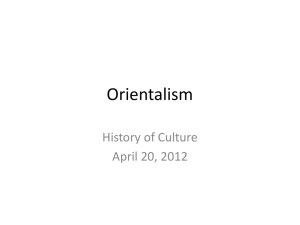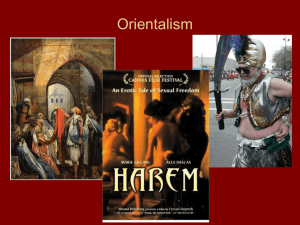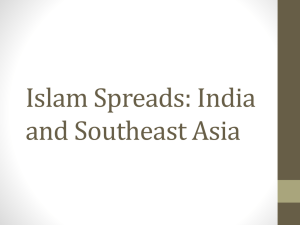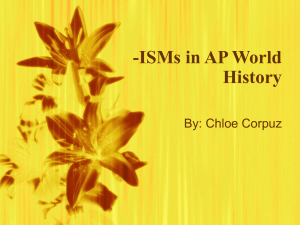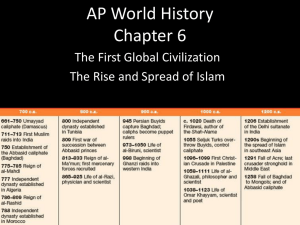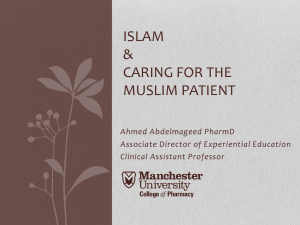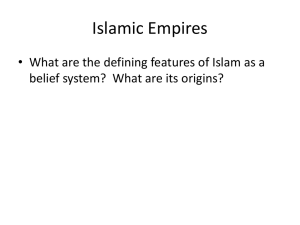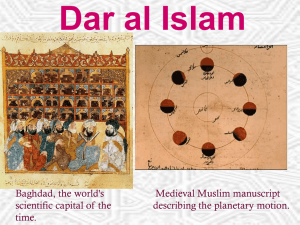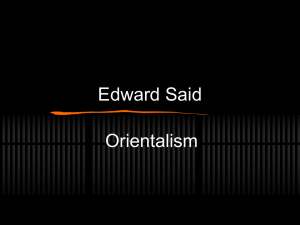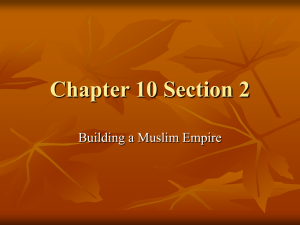Week 9 Lecture 1 Race
advertisement
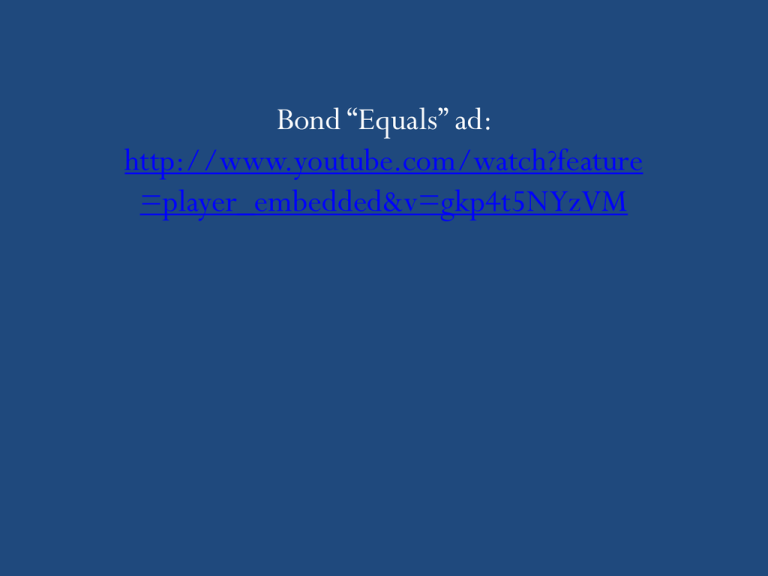
Bond “Equals” ad: http://www.youtube.com/watch?feature =player_embedded&v=gkp4t5NYzVM Week 9 – Race – Looking at “the Other” Said’s “Covering Islam” – Looking at European and American Coverage of the Protests • Introduce a basic critical vocabulary to students’ discussions of the media. • Understand criticisms of media through frameworks of race, Orientalism and others. • Three examples of looking at the Other… – Look at some common stereotypes in our favorite movies. – How the Western media reports on the rest of the world, – Look at Said’s idea of Orientalism Covering Islam to look at European and American coverage of the protests in the Middle East, What do we mean by “Other” • “the act of emphasizing the perceived weaknesses of marginalized groups as a way of stressing the alleged strength of those in positions of power.” (MartinJones, paraprasing Said) • Othering can be done with any racial, ethnic, religious, or geographically-defined category of people. Stereotypes about “the Other’ in Media • Similar to the gender stereotypes we discussed • Possibly MORE dangerous, as sometimes people might only get exposure to another race through media (whereas presumably they will meet other genders every day). • Racial Stereotypes can thus be perpetuated very rigidly over time. Why do we care? Isn’t this the “hypodermic model” again? – Why important? CNN piece on Children and Colour Stereotypes: http://www.cnn.com/video/#/video/us/2010/05/1 8/ac.pkg.cooper.doll.test.part.2.cnn Hegemony • Theory of how power operates in society in relationship to culture • “particular attention should be given to 'everyday' routine structures and 'common sense' values in trying to locate mechanisms of domination” (Gitlin, 1994:517). Mistry, Reena. Gramsci’s Theory of Hegemony http://www.theory.org.uk/ctr-rol6.htm In Entertainment… • • • • Hall’s “Three Images” of the other in popular media 1.The Slave Figure – servile, loyal 2.The Native – primitive, cunning, dangerous 3. The Clown or Entertainer – “inherent” funniness of the other Mistry, Reena. Gramsci’s Theory of Hegemony http://www.theory.org.uk/ctr-rol6.htm …Disney! • Crows in Dumbo: http://www.youtube.com/watch?v=xKjJMcJG9z8 • Siamese Cats: http://www.youtube.com/watch?v=TpPGE_SKtA 4&feature=related • Peter Pan – “Indian” sequence: http://www.youtube.com/watch?v=Y_at9dOElQ k&feature=player_embedded#at=82 • “Tony Freeth (producer, director and active member of the Campaign Against Racism in the Media, CARM) adeptly puts this concept into the context of his experience of the BBC: ’…No one in TV shouts racist abuse at black people… No one in TV physically assaults black people, they simply feed us on a diet of "Blacks are the problem"' (Freeth, 1985:26-7).” • (Could be Blacks, Muslims, poor Whites, Chinese…depends on who is creating the media! The “Other” is the problem). Mistry, Reena. Gramsci’s Theory of Hegemony http://www.theory.org.uk/ctr-rol6.htm In News: How “the West” reports on “the Rest” • Dahlgreen and Chakrapani (1979) looked at how network TV news covered the Rest of the World. • Found “three major motifs” • Used Levi Strauss’ theory of “binary opposition” to say that for each motif, the opposite is invoked. • These oppositions “situate the audience in a particular manner toward the [Rest of the] World”. Dahlgreen and Chakrapani (1979) How “the West” reports on “the Rest” Motif (How the “Other” is portrayed in the news) Binary Opposition (the implication, how the “West” is). Social Disorder and Violence Order and Stability Flawed Development Successful Development Primitivism Modernism Dahlgreen and Chakrapani (1979) These binaries create irony • As in literature or theater theory, • Irony: “a relationship between the audience of a drama and the main protagonist in that drama, where the audience is situated in a position of superior knowledge” to the protagonist. • Western news puts the viewer in a position of “knowing better” than the people they are watching. 1. Violence • “Disorder looms eternal in the Third World, according to the cumulative imagery that emerges from news reports.” • Violent stories are never presented in context. • Violence is shown in the foreground – longer term social and political aspects of the story are put in the background. • Example: Fox News, (From 4:20 after Fox reporters report, http://www.youtube.com/watch?v=nqhhgc5AWtI ) 2. Flawed Development • “Reforms” and “elections” signal a “positive step”. • “NEWS STORIES usually make it clear that the road to development along Western models is a difficult one. Chief among the obstacles which may flaw this march of progress is...[violence] and the corruption of local officials…human rights abuses.” • Example: Kenya Elections http://www.youtube.com/watch?v=sMI3D1Tg 6uk – The point is not that this story isn’t true, but the point is we don’t get much context. Just that there was violence, and now things are a bit better. 3. Primitivism • Idealization of “the primitive” • Europeans – and many cultures- have always idealized the idea of an earlier, pre-modern culture that is somehow more free. • Stories about the West are historically situated. • Stories about the rest are historical, stress “eternal and recurring features of the human condition.” • *Of course the opposite may be true in nonWestern media. Which of these, if any, can we see in this clip? • 1940s Cairo travel film, made by Americans for an American Audience: http://www.youtube.com/watch?v=DxzCH2hw WKk – No violence. – Possibly flawed development. – Possibly “primitivism.” – A-historical or historical? Edward Said on “Covering Islam” • Covering Islam: How the Media and Experts Determine HowWe See the Rest of theWorld (1997) Said- “Orientalism” • “Unlike the Americans, the French and British--less so the Germans, Russians, Spanish, Portugese, Italians, and Swiss--have had a long tradition of what I shall be calling Orientalism, a way of coming to terms with the Orient that is based on the Orient's special place in European Western Experience…” Said • “ The Orient is not only adjacent to Europe; it is also the place of Europe's greatest and richest and oldest colonies, the source of its civilizations and languages, its cultural contestant, and one of its deepest and most recurring images of the Other. In addition, the Orient has helped to define Europe (or the West) as its contrasting image, idea, personality, experience.Yet none of this Orient is merely imaginative. The Orient is an integral part of European material civilization and culture. Orientalism expresses and represents that part culturally and even ideologically as a a mode of discourse with supporting institutions, vocabulary, scholarship, imagery, doctrines, even colonial bureaucracies and colonial styles. . . .” Said on Portrayal of Middle East in European and American Media • Examples of “Word Politics” • Even News is never “objective” • “Objectivity is assumed to [be part of] learned discourse about other societies, despite the long history of political moral, and religious concern felt in all societies, Western or Islamic, about he alien, the strange and different.” (Ivii) “Experts on the Islamic World” • “Pontificate on formulaic ideas about Islam on news programmes or talk shows.” (Said xvi) • Experts and journalists “associate…Islam and fundamentalism…ensur[i ng] that the average reader comes to see Islam and fundamentalism as essentially the same thing.” (Said xvi) • “The Red Menace is Gone. But Here’s Islam” (New York Times, January 21 1996) A German youth carried a national flag and an anti-Islamic sign during a march in opposition to the building of a mosque in Cologne, Germany, in 2009.Wolfgang Rattay/Reuters • “I am not saying Muslims have not attacked and injured Israelis and Westerners in the name of Islam. But I am saying that much of what one reads and sees in the media about Islam represents the aggression as coming from Islam because that is what “Islam” is.” (Said, xxvi) • Fox News: About “Islam: What the West Needs to Know? http://www.youtube.com/watch?v=24ndfid_UuQ Generalization • Said writes “Malicious generalizations about Islam have become the last acceptable form of denigration of foreign culture in the West, what is said about the Muslim mind, or character, or religion, or culture as a whole cannot now be said in mainstream discussion about [other groups.]” (xii) • What about Africans, Jews, poor people? • Even MSM sometimes generalizes about these groups… • But Said’s general point about representation is important: – Always be alert to generalizations in news media. – Always remember that news media operates under certain constraints and cannot provide the whole story. Is all this less relevant today? • Where do people get these kinds of ideas – if not the media? • Orange County, CA, last week… (March 2011) – http://www.youtube.com/watch?v=e6t6d9YBuFM Short Break Activity On the Media “Protest” or “Rebellion” • Together, listen to this (6 minutes): http://www.onthemedia.org/transcripts/2011/03 /04/01 • How language frames the news. • To help prepare for exam section that deals with this. Story How Each Side Is Described Source Cote D’Ivoire “confrontations between security forces loyal to the country's incumbent president Laurent Gbagbo and the exrebel New Forces (FN),” Xinhua.cn Libya “government forces” versus NYTimes “rebels” Over in A1…Find 5 articles or clips online from any non-middle eastern source (could be American, African, Chinese, whatever…) about what is happening in Iraq, Libya, Egypt, or Bahrain, Cote d’Ivoire. Take note what kind of words are used to describe the the conflict. Input data into chart >> (on next slide)… you’ll have 30-40 mins, then we will discuss. • Listen to this podcast: On The Media,The Arab Street.http://www.onthemedia.org/episodes/2011/02/0 4/segments/158942 • Gameology. “The Orientalist Perspective: Cultural Imperialism in Gaming”. <http://www.gameology.org/essays/the_orientalist_p erspective_cultural_imperialism_in_gaming > • Culler, Jonathan, “Literary Theory: A Very Short Introduction.” (2000) (Copies to be provided) • Said, Edward. “Introductions(s),” Covering Islam, Vintage, 1997 and 1981. (Copies to be provided) •
